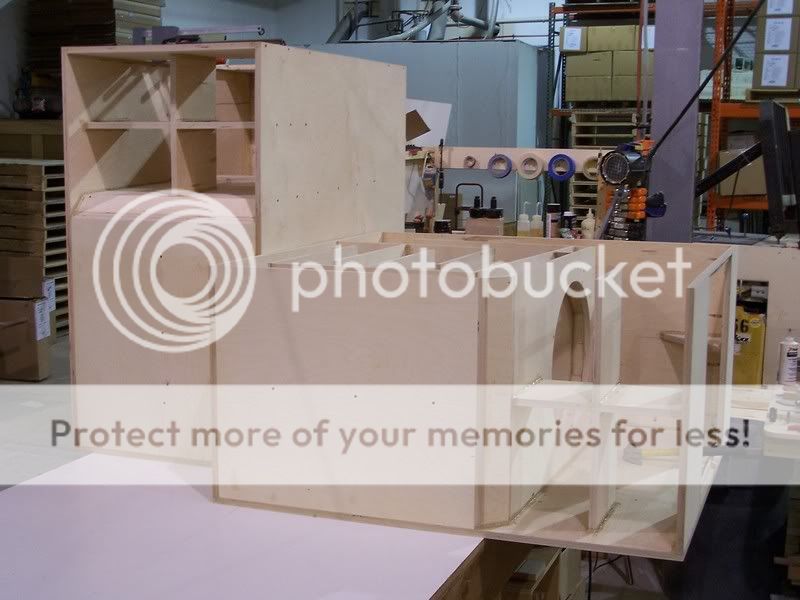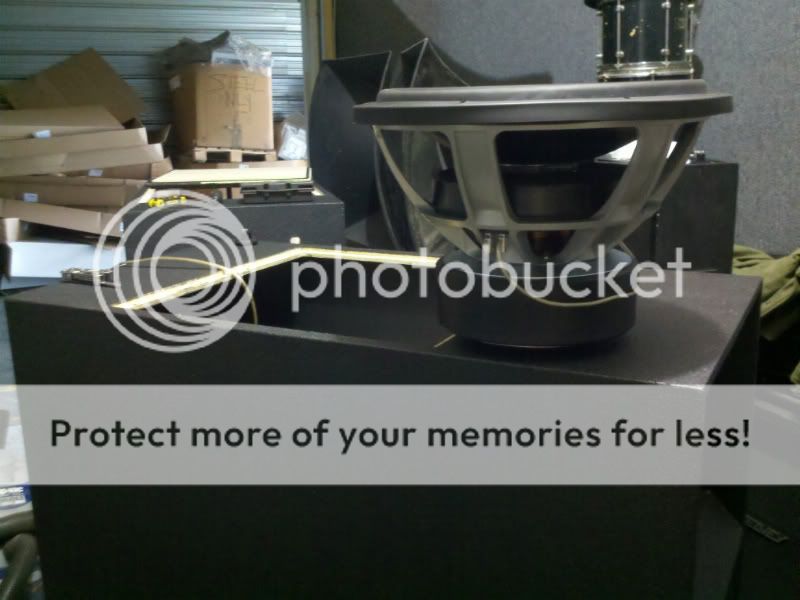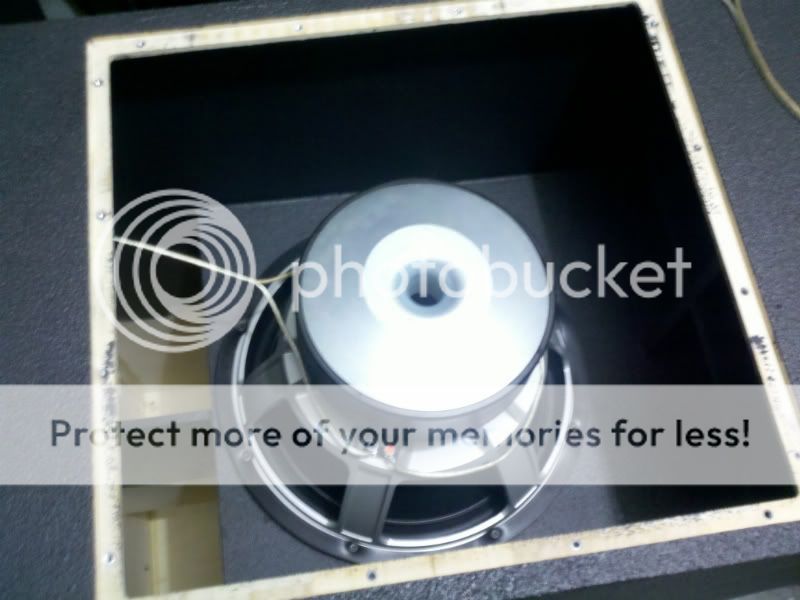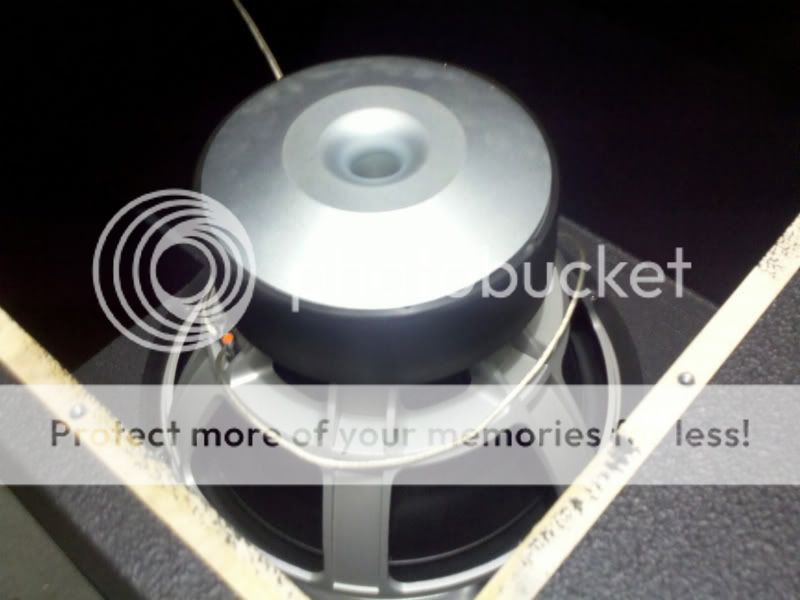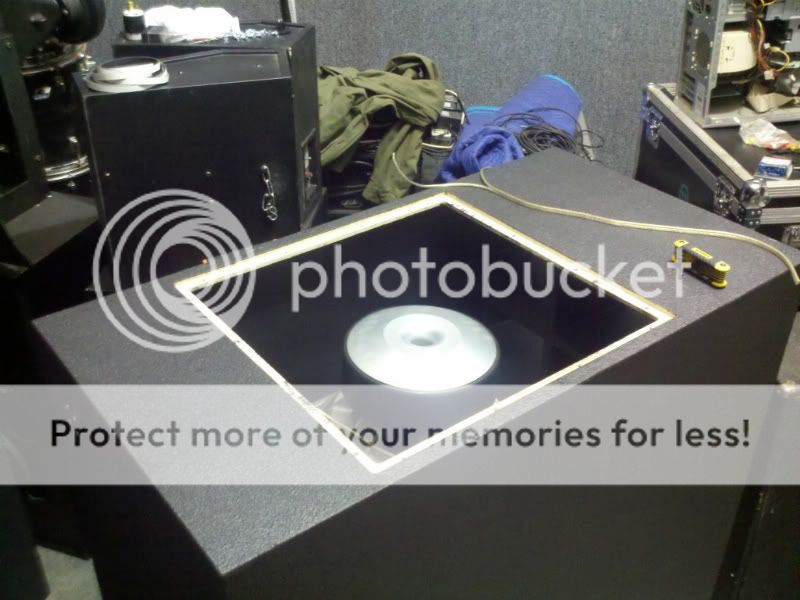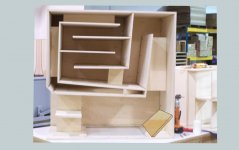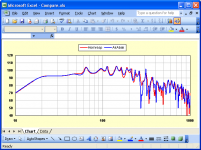I have been working on a couple of tapped bass horn designs for many months now. This design is centered around a large 45x45x24" cabinet form and a single LMS Ultra 5400 driver. The weight with the 80lb driver loaded in is probably near 300lbs. The cabs are built from 18mm and 12mm BB and put together with PL premium construction adhesive and pocket screws. The drivers and access panel mount with 1/4x20 screws and threaded inserts. The finish is Duratex. A gallon and a half on each cab. The access panel is purposely large enough to allow for even 21" drivers. Other 18" or 21" drivers may be useable in this cab.
I did all of the simulating in HR but quickly jumped to Akabak after realizing that the process worked better designing the physical cabinet and horn fold first and then translating that into Akabak script instead of trying to optimize some simulation and then realizing that it would not fit into the cabinet, was too big, ended up with dead spaces in the cab, or otherwise had problems with real world buildability. This was a many month wash, rinse, repeat process of refinement. Once I got a fold layout that actually fit in the cab confines it was a manor of much tweaking to try and improve it with what was available. When I was happy with the compromises and that I would not get it any better I was lucky enough to have a friend offer to build the cabs at his cost at his professional cabinet shop. That took about 2 or 3 months. I had originally planned to build them myself but to be completely honest I am so glad that I didn't have to. I wouldn't have gotten them done near as quickly or with the same quality. Additionally these cabs were sort of a risk. There was no prototype and with something this large it would be easy to make mistakes and screw something up either in the build or while simulating. It wouldn't take much for it to be just and expensive and time consuming pile of scrap wood. There is also some concern over whether the driver will withstand the pressures in the horn, whether this driver is suited to a TH and about the effect that the folding will have on things. The fold of the horn is not elegant by any means. It has a number of 90 deg turns and many relatively short sections. I tried for weeks to come up with a fold to fit in this cabinet size with the right length and this is what I could get to work. It has compromises. We will see how bad they turn out to be. I tried to model the cabinet being built as accurately as possible but you can't get everything.
My inspiration for these was the Danley Th50 which I was quite impressed by when I heard it and the DTS-10 of which I own a pair of and happen to have been lucky enough to have had a very small hand in its development through correspondance with Tom. The goal is for something to use in LARGE open spaces and big rooms without a lot of gain and longer than normal listening distances. The goal was to cover 16-100hz well in a cab that wasn't too gigantic which is how I ended up at a size similar to a Labsub but slightly wider. That form fits almost perfectly into the space that I have available for the pair also. The effective lower limit on these according to the simulation should be just below 15hz at full power input. These should be safe from over excursion with 130v peaks anywhere above 14.5hz. I am going to use this pair as the anchor in my system at a warehouse space which is about 10,000cu ft and really lossy. There is not much room gain there to speak of until the really low freq's. I figure that 4 of these could rock a large commercial sized movie theater very well. That was really sort of the idea with this was, what would be suitable to cover 15-80hz for an Imax? So to answer the question it is something designed for my purposes and was never really meant to be a ht or music sub in someone's living room, being quite gigantic, heavy and rather overkill. A pair would be devastating in a typical domestic sized room or house. It is also not really suited to typical live sound or mobile SR as it has extension an octave lower than needed. Might be good for some high power dubstep or DnB though.
Anyway here is a rough HornResponse approximation of the Akabak script.

Here is the Akabak script. I ran out of sections.
|COMMENT:LMS5400 ULTRA 18hz 45x45x24 TH 020411 FINAL, no dead space, straight throat, with constriction, big mouth(LMS obstructs roughly 613cm2)
|=========================================================== =============================================
|REQUIRED AKABAK SETTINGS:
|File > Preferences > Physical system constants:
|Sound velocity c = 344m/s
|Medium density rho = 1.205kg/m3
|Sum > Acoustic power:
|Frequency range = 10Hz to 20kHz
|Points = 533
|Input voltage = 1.97V rms
|Integration = 2Pi-sr
|Integration steps = 1 degree ... 1 degree
|Integration method = Cross
|=========================================================== =============================================
Def_Const |Input Parameter Values
{
|Length, area and volume values converted to metres, square metres and cubic metres:
S1 = 82.90855e-4; |Horn segment 1 throat area (sq cm)
S2 = 308.14365e-4; |Horn segment 1 mouth area and horn segment 2 throat area (sq cm)
S3 = 453.98375e-4; |Horn segment 2 mouth area and horn segment 3 throat area (sq cm)
S4 = 226.85056e-4; |Horn segment 3 mouth area and horn segment 4 throat area (sq cm)/ brace area
S5 = 249.88796e-4; |Horn segment 4 mouth area and horn segment 5 throat area (sq cm)/ brace area
S6 = 513.6456e-4; |Horn segment 5 mouth area and horn segment 6 throat area (sq cm)
S7 = 729.21504e-4; |Horn segment 6 mouth area and horn segment 7 throat area (sq cm)
S8 = 517.6522e-4; |Horn segment 7 mouth area and horn segment 8 throat area (sq cm)
S9 = 254.60955e-4; |Horn segment 8 mouth area and horn segment 9 throat area (sq cm)/ brace area
S10 = 278.2318e-4; |Horn segment 9 mouth area and horn segment 10 throat area (sq cm)/ brace area
S11 = 570.7141e-4; |Horn segment 10 mouth area and horn segment 11 throat area (sq cm)
S12 = 846.68843e-4; |Horn segment 11 mouth area and horn segment 12 throat area (sq cm)
S13 = 579.57232e-4; |Horn segment 12 mouth area and horn segment 13 throat area (sq cm)
S14 = 795.34572e-4; |Horn segment 13 mouth area and horn segment 14 throat area (sq cm)
S15 = 587.76034e-4; |Horn segment 14 mouth area and horn segment 15 throat area (sq cm)
S16 = 628.4965e-4; |Horn segment 15 mouth area and horn segment 16 throat area (sq cm)
S17 = 894.92785e-4; |Horn segment 16 mouth area and horn segment 17 throat area (sq cm)
S18 = 637.70438e-4; |Horn segment 17 mouth area and horn segment 18 throat area (sq cm)
S19 = 908.89994e-4; |Horn segment 18 mouth area and horn segment 19 throat area (sq cm)
S20 = 647.05796e-4; |Horn segment 19 mouth area and horn segment 20 throat area (sq cm)
S21 = 684.16633e-4; |Horn segment 20 mouth area and horn segment 21 throat area (sq cm)
S22 = 1014.9946e-4; |Horn segment 21 mouth area and horn segment 22 throat area (sq cm)
S23 = 694.67089e-4; |Horn segment 22 mouth area and horn segment 23 throat area (sq cm)
S24 = 955.76983e-4; |Horn segment 23 mouth area and horn segment 24 throat area (sq cm)
S25 = 704.47613e-4; |Horn segment 24 mouth area and horn segment 25 throat area (sq cm)
S26 = 728.39915e-4; |Horn segment 25 mouth area and horn segment 26 throat area (sq cm)
S27 = 1037.1547e-4; |Horn segment 26 mouth area and horn segment 27 throat area (sq cm)
S28 = 739.10769e-4; |Horn segment 27 mouth area and horn segment 28 throat area (sq cm)
S29 = 1019.4091e-4; |Horn segment 28 mouth area and horn segment 29 throat area (sq cm)
S30 = 749.69967e-4; |Horn segment 29 mouth area and horn segment 30 throat area (sq cm)
S31 = 964.5552e-4; |Horn segment 30 mouth area and horn segment 31 throat area (sq cm)
S32 = 1367.7644e-4; |Horn segment 31 mouth area and horn segment 32 throat area (sq cm)
S33 = 989.80404e-4; |Horn segment 32 mouth area and horn segment 33 throat area (sq cm)
S34 = 1038.2765e-4; |Horn segment 33 mouth area and horn segment 34 throat area (sq cm)
S35 = 1428.0236e-4; |Horn segment 34 mouth area and horn segment 35 throat area (sq cm)
S36 = 1058.7029e-4; |Horn segment 35 mouth area and horn segment 36 throat area (sq cm)
S37 = 1060.4949e-4; |Horn segment 36 mouth area and horn segment 37 throat area (sq cm)
S38 = 1509.5979e-4; |Horn segment 37 mouth area and horn segment 38 throat area (sq cm)
S39 = 1075.8948e-4; |Horn segment 38 mouth area and horn segment 39 throat area (sq cm)
S40 = 532.2565e-4; |Horn segment 39 mouth area and horn segment 40 throat area (sq cm)/ brace area
S41 = 682.62005e-4; |Horn segment 40 mouth area and horn segment 41 throat area (sq cm)/ brace area
S42 = 1413.3813e-4; |Horn segment 41 mouth area and horn segment 42 throat area (sq cm)
S43 = 2501.1503e-4; |Horn segment 42 mouth area and horn segment 43 throat area (sq cm)
S44 = 2065.1744e-4; |Horn segment 43 mouth area and horn segment 44 throat area (sq cm)
S45 = 2067.7094e-4; |Horn segment 44 mouth area and horn segment 45 throat area (sq cm)
S46 = 1505.2217e-4; |Horn segment 45 mouth area and horn segment 46 throat area (sq cm)/ (1505.2217 with driver restriction, 2118.2217 without)
S47 = 2167.5538e-4; |Horn segment 46 mouth area and horn segment 47 throat area (sq cm)
S48 = 2237.6765e-4; |Horn segment 47 mouth area and horn segment 48 throat area (sq cm)
S49 = 2611.6741e-4; |Horn segment 48 mouth area (sq cm)
L12 = 23.64486e-2; |Horn segment 1 axial length (cm)
L23 = 54.00802e-2; |Horn segment 2 axial length (cm)
L34 = 8.93572e-2; |Horn segment 3 axial length (cm)brace area
L45 = 47.001684e-2; |Horn segment 4 axial length (cm)
L56 = 3.214878e-2; |Horn segment 5 axial length (cm)
L67 = 3.504946e-2; |Horn segment 6 axial length (cm)
L78 = 3.563112e-2; |Horn segment 7 axial length (cm)
L89 = 2.418334e-2; |Horn segment 8 axial length (cm)brace area
L910 = 48.208438e-2; |Horn segment 9 axial length (cm)
L1011 = 2.373376e-2; |Horn segment 10 axial length (cm)
L1112 = 4.11353e-2; |Horn segment 11 axial length (cm)
L1213 = 4.7655988e-2; |Horn segment 12 axial length (cm)
L1314 = 4.3843448e-2; |Horn segment 13 axial length (cm)
L1415 = 3.827526e-2; |Horn segment 14 axial length (cm)
L1516 = 40.694864e-2; |Horn segment 15 axial length (cm)
L1617 = 4.298442e-2; |Horn segment 16 axial length (cm)
L1718 = 4.9505108e-2; |Horn segment 17 axial length (cm)
L1819 = 4.9652428e-2; |Horn segment 18 axial length (cm)
L1920 = 4.418838e-2; |Horn segment 19 axial length (cm)
L2021 = 37.065458e-2; |Horn segment 20 axial length (cm)
L2122 = 4.912106e-2; |Horn segment 21 axial length (cm)
L2223 = 5.5748428e-2; |Horn segment 22 axial length (cm)
L2324 = 5.1532028e-2; |Horn segment 23 axial length (cm)
L2425 = 4.58724e-2; |Horn segment 24 axial length (cm)
L2526 = 35.401758e-2; |Horn segment 25 axial length (cm)
L2627 = 4.999228e-2; |Horn segment 26 axial length (cm)
L2728 = 5.6479948e-2; |Horn segment 27 axial length (cm)
L2829 = 5.4557168e-2; |Horn segment 28 axial length (cm)
L2930 = 5.119624e-2; |Horn segment 29 axial length (cm)
L3031 = 47.806102e-2; |Horn segment 30 axial length (cm)
L3132 = 6.366002e-2; |Horn segment 31 axial length (cm)
L3233 = 6.6675e-2; |Horn segment 32 axial length (cm)
L3334 = 32.559498e-2; |Horn segment 33 axial length (cm)
L3435 = 6.745478e-2; |Horn segment 34 axial length (cm)
L3536 = 6.860286e-2; |Horn segment 35 axial length (cm)
L3637 = 1.203452e-2; |Horn segment 36 axial length (cm)
L3738 = 7.239254e-2; |Horn segment 37 axial length (cm)
L3839 = 7.780782e-2; |Horn segment 38 axial length (cm)
L3940 = 1.651254e-2; |Horn segment 39 axial length (cm)brace area
L4041 = 51.303936e-2; |Horn segment 40 axial length (cm)
L4142 = 3.48996e-2; |Horn segment 41 axial length (cm)
L4243 = 12.146026e-2; |Horn segment 42 axial length (cm)
L4344 = 10.563352e-2; |Horn segment 43 axial length (cm)
L4445 = 1.200658e-2; |Horn segment 44 axial length (cm)
L4546 = 23.711916e-2; |Horn segment 45 axial length (cm)
L4647 = 23.490936e-2; |Horn segment 46 axial length (cm)
L4748 = 33.151826e-2; |Horn segment 47 axial length (cm)
L4849 = 6.847332e-2; |Horn segment 47 axial length (cm)
Vtc = 3500.00e-6; |Throat chamber volume (cc)
Atc = 1465.00e-4; |Throat chamber cross-sectional area (sq cm)
|Parameter Conversions:
Sd = 1194.60e-4; |Diaphragm area (sq cm)
Ltc = Vtc / Atc;
}
|=========================================================== =============================================
|Network node numbers for this tapped horn system:
| 0-Voltage-1
| |
| -Chamber-5-Driver---
| | |
|8-Segment-9-Segment-10-Segment-11-Segment-12-Segment-13-Segment-14-Segment-15-Segment-16-Segment-17-Segment-18-Segment-19-Segment-20-Segment-21-Segment-22-Segment-23-Segment-24-Segment-25-Segment-26-Segment-27-Segment-28-Segment-29-Segment-30-Segment-31-Segment-32-Segment-33-Segment-34-Segment-35-Segment-36-Segment-37-Segment-38-Segment-39-Segment-40-Segment-41-Segment-42-Segment-43-Segment-44-Segment-45-Segment-46-Segment-47-Segment-48-Segment-49-Segment-50-Segment-51-Segment-52-Segment-53-Segment-54-Segment-55-Segment-56-Radiator
|=========================================================== =============================================
Def_Driver 'Driver'
Sd=1194.60cm2
Bl=26.93Tm
Cms=1.19E-04m/N
Rms=8.58Ns/m
fs=20.5001Hz |Mmd = 482.71g not recognised by AkAbak, fs calculated and used instead
Le=2.80mH
Re=3.78ohm
ExpoLe=1
System 'System'
Driver Def='Driver''Driver'
Node=1=0=5=53
Duct 'Throat chamber'
Node=5=9
SD={Atc}
Len={Ltc}
Visc=0
Waveguide 'Horn segment 1'
Node=8=9
STh={S1}
SMo={S2}
Len={L12}
Waveguide 'Horn segment 2'
Node=9=10
STh={S2}
SMo={S3}
Len={L23}
Waveguide 'Horn segment 3'
Node=11=10
STh={S4}
SMo={S3}
Len={L34}
Waveguide 'Horn segment 4'
Node=11=12
STh={S4}
SMo={S5}
Len={L45}
Waveguide 'Horn segment 4B'
Node=11=12
STh={S4}
SMo={S5}
Len={L45}
Waveguide 'Horn segment 5'
Node=12=13
STh={S5}
SMo={S6}
Len={L56}
Waveguide 'Horn segment 6'
Node=13=14
STh={S6}
SMo={S7}
Len={L67}
Waveguide 'Horn segment 7'
Node=15=14
STh={S8}
SMo={S7}
Len={L78}
Waveguide 'Horn segment 8'
Node=16=15
STh={S9}
SMo={S8}
Len={L89}
Waveguide 'Horn segment 9'
Node=16=17
STh={S9}
SMo={S10}
Len={L910}
Waveguide 'Horn segment 9B'
Node=16=17
STh={S9}
SMo={S10}
Len={L910}
Waveguide 'Horn segment 10'
Node=17=18
STh={S10}
SMo={S11}
Len={L1011}
Waveguide 'Horn segment 11'
Node=18=19
STh={S11}
SMo={S12}
Len={L1112}
Waveguide 'Horn segment 12'
Node=20=19
STh={S13}
SMo={S12}
Len={L1213}
Waveguide 'Horn segment 13'
Node=20=21
STh={S13}
SMo={S14}
Len={L1314}
Waveguide 'Horn segment 14'
Node=22=21
STh={S15}
SMo={S14}
Len={L1415}
Waveguide 'Horn segment 15'
Node=22=23
STh={S15}
SMo={S16}
Len={L1516}
Waveguide 'Horn segment 16'
Node=23=24
STh={S16}
SMo={S17}
Len={L1617}
Waveguide 'Horn segment 17'
Node=25=24
STh={S18}
SMo={S17}
Len={L1718}
Waveguide 'Horn segment 18'
Node=25=26
STh={S18}
SMo={S19}
Len={L1819}
Waveguide 'Horn segment 19'
Node=27=26
STh={S20}
SMo={S19}
Len={L1920}
Waveguide 'Horn segment 20'
Node=27=28
STh={S20}
SMo={S21}
Len={L2021}
Waveguide 'Horn segment 21'
Node=28=29
STh={S21}
SMo={S22}
Len={L2122}
Waveguide 'Horn segment 22'
Node=30=29
STh={S23}
SMo={S22}
Len={L2223}
Waveguide 'Horn segment 23'
Node=30=31
STh={S23}
SMo={S24}
Len={L2324}
Waveguide 'Horn segment 24'
Node=32=31
STh={S25}
SMo={S24}
Len={L2425}
Waveguide 'Horn segment 25'
Node=32=33
STh={S25}
SMo={S26}
Len={L2526}
Waveguide 'Horn segment 26'
Node=33=34
STh={S26}
SMo={S27}
Len={L2627}
Waveguide 'Horn segment 27'
Node=35=34
STh={S28}
SMo={S27}
Len={L2728}
Waveguide 'Horn segment 28'
Node=35=36
STh={S28}
SMo={S29}
Len={L2829}
Waveguide 'Horn segment 29'
Node=37=36
STh={S30}
SMo={S29}
Len={L2930}
Waveguide 'Horn segment 30'
Node=37=38
STh={S30}
SMo={S31}
Len={L3031}
Waveguide 'Horn segment 31'
Node=38=39
STh={S31}
SMo={S32}
Len={L3132}
Waveguide 'Horn segment 32'
Node=40=39
STh={S33}
SMo={S32}
Len={L3233}
Waveguide 'Horn segment 33'
Node=40=41
STh={S33}
SMo={S34}
Len={L3334}
Waveguide 'Horn segment 34'
Node=41=42
STh={S34}
SMo={S35}
Len={L3435}
Waveguide 'Horn segment 35'
Node=43=42
STh={S36}
SMo={S35}
Len={L3536}
Waveguide 'Horn segment 36'
Node=43=44
STh={S36}
SMo={S37}
Len={L3637}
Waveguide 'Horn segment 37'
Node=44=45
STh={S37}
SMo={S38}
Len={L3738}
Waveguide 'Horn segment 38'
Node=46=45
STh={S39}
SMo={S38}
Len={L3839}
Waveguide 'Horn segment 39'
Node=47=46
STh={S40}
SMo={S39}
Len={L3940}
Waveguide 'Horn segment 40'
Node=47=48
STh={S40}
SMo={S41}
Len={L4041}
Waveguide 'Horn segment 40B'
Node=47=48
STh={S40}
SMo={S41}
Len={L4041}
Waveguide 'Horn segment 41'
Node=48=49
STh={S41}
SMo={S42}
Len={L4142}
Waveguide 'Horn segment 42'
Node=49=50
STh={S42}
SMo={S43}
Len={L4243}
Waveguide 'Horn segment 43'
Node=51=50
STh={S44}
SMo={S43}
Len={L4344}
Waveguide 'Horn segment 44'
Node=51=52
STh={S44}
SMo={S45}
Len={L4445}
Waveguide 'Horn segment 45'
Node=53=52
STh={S46}
SMo={S45}
Len={L4546}
Waveguide 'Horn segment 46'
Node=53=54
STh={S46}
SMo={S47}
Len={L4647}
Waveguide 'Horn segment 47'
Node=54=55
STh={S47}
SMo={S48}
Len={L4748}
Waveguide 'Horn segment 48'
Node=55=56
STh={S48}
SMo={S49}
Len={L4849}
Radiator 'Horn mouth'
Node=56
SD={S49}
__________________
I did all of the simulating in HR but quickly jumped to Akabak after realizing that the process worked better designing the physical cabinet and horn fold first and then translating that into Akabak script instead of trying to optimize some simulation and then realizing that it would not fit into the cabinet, was too big, ended up with dead spaces in the cab, or otherwise had problems with real world buildability. This was a many month wash, rinse, repeat process of refinement. Once I got a fold layout that actually fit in the cab confines it was a manor of much tweaking to try and improve it with what was available. When I was happy with the compromises and that I would not get it any better I was lucky enough to have a friend offer to build the cabs at his cost at his professional cabinet shop. That took about 2 or 3 months. I had originally planned to build them myself but to be completely honest I am so glad that I didn't have to. I wouldn't have gotten them done near as quickly or with the same quality. Additionally these cabs were sort of a risk. There was no prototype and with something this large it would be easy to make mistakes and screw something up either in the build or while simulating. It wouldn't take much for it to be just and expensive and time consuming pile of scrap wood. There is also some concern over whether the driver will withstand the pressures in the horn, whether this driver is suited to a TH and about the effect that the folding will have on things. The fold of the horn is not elegant by any means. It has a number of 90 deg turns and many relatively short sections. I tried for weeks to come up with a fold to fit in this cabinet size with the right length and this is what I could get to work. It has compromises. We will see how bad they turn out to be. I tried to model the cabinet being built as accurately as possible but you can't get everything.
My inspiration for these was the Danley Th50 which I was quite impressed by when I heard it and the DTS-10 of which I own a pair of and happen to have been lucky enough to have had a very small hand in its development through correspondance with Tom. The goal is for something to use in LARGE open spaces and big rooms without a lot of gain and longer than normal listening distances. The goal was to cover 16-100hz well in a cab that wasn't too gigantic which is how I ended up at a size similar to a Labsub but slightly wider. That form fits almost perfectly into the space that I have available for the pair also. The effective lower limit on these according to the simulation should be just below 15hz at full power input. These should be safe from over excursion with 130v peaks anywhere above 14.5hz. I am going to use this pair as the anchor in my system at a warehouse space which is about 10,000cu ft and really lossy. There is not much room gain there to speak of until the really low freq's. I figure that 4 of these could rock a large commercial sized movie theater very well. That was really sort of the idea with this was, what would be suitable to cover 15-80hz for an Imax? So to answer the question it is something designed for my purposes and was never really meant to be a ht or music sub in someone's living room, being quite gigantic, heavy and rather overkill. A pair would be devastating in a typical domestic sized room or house. It is also not really suited to typical live sound or mobile SR as it has extension an octave lower than needed. Might be good for some high power dubstep or DnB though.
Anyway here is a rough HornResponse approximation of the Akabak script.

Here is the Akabak script. I ran out of sections.

|COMMENT:LMS5400 ULTRA 18hz 45x45x24 TH 020411 FINAL, no dead space, straight throat, with constriction, big mouth(LMS obstructs roughly 613cm2)
|=========================================================== =============================================
|REQUIRED AKABAK SETTINGS:
|File > Preferences > Physical system constants:
|Sound velocity c = 344m/s
|Medium density rho = 1.205kg/m3
|Sum > Acoustic power:
|Frequency range = 10Hz to 20kHz
|Points = 533
|Input voltage = 1.97V rms
|Integration = 2Pi-sr
|Integration steps = 1 degree ... 1 degree
|Integration method = Cross
|=========================================================== =============================================
Def_Const |Input Parameter Values
{
|Length, area and volume values converted to metres, square metres and cubic metres:
S1 = 82.90855e-4; |Horn segment 1 throat area (sq cm)
S2 = 308.14365e-4; |Horn segment 1 mouth area and horn segment 2 throat area (sq cm)
S3 = 453.98375e-4; |Horn segment 2 mouth area and horn segment 3 throat area (sq cm)
S4 = 226.85056e-4; |Horn segment 3 mouth area and horn segment 4 throat area (sq cm)/ brace area
S5 = 249.88796e-4; |Horn segment 4 mouth area and horn segment 5 throat area (sq cm)/ brace area
S6 = 513.6456e-4; |Horn segment 5 mouth area and horn segment 6 throat area (sq cm)
S7 = 729.21504e-4; |Horn segment 6 mouth area and horn segment 7 throat area (sq cm)
S8 = 517.6522e-4; |Horn segment 7 mouth area and horn segment 8 throat area (sq cm)
S9 = 254.60955e-4; |Horn segment 8 mouth area and horn segment 9 throat area (sq cm)/ brace area
S10 = 278.2318e-4; |Horn segment 9 mouth area and horn segment 10 throat area (sq cm)/ brace area
S11 = 570.7141e-4; |Horn segment 10 mouth area and horn segment 11 throat area (sq cm)
S12 = 846.68843e-4; |Horn segment 11 mouth area and horn segment 12 throat area (sq cm)
S13 = 579.57232e-4; |Horn segment 12 mouth area and horn segment 13 throat area (sq cm)
S14 = 795.34572e-4; |Horn segment 13 mouth area and horn segment 14 throat area (sq cm)
S15 = 587.76034e-4; |Horn segment 14 mouth area and horn segment 15 throat area (sq cm)
S16 = 628.4965e-4; |Horn segment 15 mouth area and horn segment 16 throat area (sq cm)
S17 = 894.92785e-4; |Horn segment 16 mouth area and horn segment 17 throat area (sq cm)
S18 = 637.70438e-4; |Horn segment 17 mouth area and horn segment 18 throat area (sq cm)
S19 = 908.89994e-4; |Horn segment 18 mouth area and horn segment 19 throat area (sq cm)
S20 = 647.05796e-4; |Horn segment 19 mouth area and horn segment 20 throat area (sq cm)
S21 = 684.16633e-4; |Horn segment 20 mouth area and horn segment 21 throat area (sq cm)
S22 = 1014.9946e-4; |Horn segment 21 mouth area and horn segment 22 throat area (sq cm)
S23 = 694.67089e-4; |Horn segment 22 mouth area and horn segment 23 throat area (sq cm)
S24 = 955.76983e-4; |Horn segment 23 mouth area and horn segment 24 throat area (sq cm)
S25 = 704.47613e-4; |Horn segment 24 mouth area and horn segment 25 throat area (sq cm)
S26 = 728.39915e-4; |Horn segment 25 mouth area and horn segment 26 throat area (sq cm)
S27 = 1037.1547e-4; |Horn segment 26 mouth area and horn segment 27 throat area (sq cm)
S28 = 739.10769e-4; |Horn segment 27 mouth area and horn segment 28 throat area (sq cm)
S29 = 1019.4091e-4; |Horn segment 28 mouth area and horn segment 29 throat area (sq cm)
S30 = 749.69967e-4; |Horn segment 29 mouth area and horn segment 30 throat area (sq cm)
S31 = 964.5552e-4; |Horn segment 30 mouth area and horn segment 31 throat area (sq cm)
S32 = 1367.7644e-4; |Horn segment 31 mouth area and horn segment 32 throat area (sq cm)
S33 = 989.80404e-4; |Horn segment 32 mouth area and horn segment 33 throat area (sq cm)
S34 = 1038.2765e-4; |Horn segment 33 mouth area and horn segment 34 throat area (sq cm)
S35 = 1428.0236e-4; |Horn segment 34 mouth area and horn segment 35 throat area (sq cm)
S36 = 1058.7029e-4; |Horn segment 35 mouth area and horn segment 36 throat area (sq cm)
S37 = 1060.4949e-4; |Horn segment 36 mouth area and horn segment 37 throat area (sq cm)
S38 = 1509.5979e-4; |Horn segment 37 mouth area and horn segment 38 throat area (sq cm)
S39 = 1075.8948e-4; |Horn segment 38 mouth area and horn segment 39 throat area (sq cm)
S40 = 532.2565e-4; |Horn segment 39 mouth area and horn segment 40 throat area (sq cm)/ brace area
S41 = 682.62005e-4; |Horn segment 40 mouth area and horn segment 41 throat area (sq cm)/ brace area
S42 = 1413.3813e-4; |Horn segment 41 mouth area and horn segment 42 throat area (sq cm)
S43 = 2501.1503e-4; |Horn segment 42 mouth area and horn segment 43 throat area (sq cm)
S44 = 2065.1744e-4; |Horn segment 43 mouth area and horn segment 44 throat area (sq cm)
S45 = 2067.7094e-4; |Horn segment 44 mouth area and horn segment 45 throat area (sq cm)
S46 = 1505.2217e-4; |Horn segment 45 mouth area and horn segment 46 throat area (sq cm)/ (1505.2217 with driver restriction, 2118.2217 without)
S47 = 2167.5538e-4; |Horn segment 46 mouth area and horn segment 47 throat area (sq cm)
S48 = 2237.6765e-4; |Horn segment 47 mouth area and horn segment 48 throat area (sq cm)
S49 = 2611.6741e-4; |Horn segment 48 mouth area (sq cm)
L12 = 23.64486e-2; |Horn segment 1 axial length (cm)
L23 = 54.00802e-2; |Horn segment 2 axial length (cm)
L34 = 8.93572e-2; |Horn segment 3 axial length (cm)brace area
L45 = 47.001684e-2; |Horn segment 4 axial length (cm)
L56 = 3.214878e-2; |Horn segment 5 axial length (cm)
L67 = 3.504946e-2; |Horn segment 6 axial length (cm)
L78 = 3.563112e-2; |Horn segment 7 axial length (cm)
L89 = 2.418334e-2; |Horn segment 8 axial length (cm)brace area
L910 = 48.208438e-2; |Horn segment 9 axial length (cm)
L1011 = 2.373376e-2; |Horn segment 10 axial length (cm)
L1112 = 4.11353e-2; |Horn segment 11 axial length (cm)
L1213 = 4.7655988e-2; |Horn segment 12 axial length (cm)
L1314 = 4.3843448e-2; |Horn segment 13 axial length (cm)
L1415 = 3.827526e-2; |Horn segment 14 axial length (cm)
L1516 = 40.694864e-2; |Horn segment 15 axial length (cm)
L1617 = 4.298442e-2; |Horn segment 16 axial length (cm)
L1718 = 4.9505108e-2; |Horn segment 17 axial length (cm)
L1819 = 4.9652428e-2; |Horn segment 18 axial length (cm)
L1920 = 4.418838e-2; |Horn segment 19 axial length (cm)
L2021 = 37.065458e-2; |Horn segment 20 axial length (cm)
L2122 = 4.912106e-2; |Horn segment 21 axial length (cm)
L2223 = 5.5748428e-2; |Horn segment 22 axial length (cm)
L2324 = 5.1532028e-2; |Horn segment 23 axial length (cm)
L2425 = 4.58724e-2; |Horn segment 24 axial length (cm)
L2526 = 35.401758e-2; |Horn segment 25 axial length (cm)
L2627 = 4.999228e-2; |Horn segment 26 axial length (cm)
L2728 = 5.6479948e-2; |Horn segment 27 axial length (cm)
L2829 = 5.4557168e-2; |Horn segment 28 axial length (cm)
L2930 = 5.119624e-2; |Horn segment 29 axial length (cm)
L3031 = 47.806102e-2; |Horn segment 30 axial length (cm)
L3132 = 6.366002e-2; |Horn segment 31 axial length (cm)
L3233 = 6.6675e-2; |Horn segment 32 axial length (cm)
L3334 = 32.559498e-2; |Horn segment 33 axial length (cm)
L3435 = 6.745478e-2; |Horn segment 34 axial length (cm)
L3536 = 6.860286e-2; |Horn segment 35 axial length (cm)
L3637 = 1.203452e-2; |Horn segment 36 axial length (cm)
L3738 = 7.239254e-2; |Horn segment 37 axial length (cm)
L3839 = 7.780782e-2; |Horn segment 38 axial length (cm)
L3940 = 1.651254e-2; |Horn segment 39 axial length (cm)brace area
L4041 = 51.303936e-2; |Horn segment 40 axial length (cm)
L4142 = 3.48996e-2; |Horn segment 41 axial length (cm)
L4243 = 12.146026e-2; |Horn segment 42 axial length (cm)
L4344 = 10.563352e-2; |Horn segment 43 axial length (cm)
L4445 = 1.200658e-2; |Horn segment 44 axial length (cm)
L4546 = 23.711916e-2; |Horn segment 45 axial length (cm)
L4647 = 23.490936e-2; |Horn segment 46 axial length (cm)
L4748 = 33.151826e-2; |Horn segment 47 axial length (cm)
L4849 = 6.847332e-2; |Horn segment 47 axial length (cm)
Vtc = 3500.00e-6; |Throat chamber volume (cc)
Atc = 1465.00e-4; |Throat chamber cross-sectional area (sq cm)
|Parameter Conversions:
Sd = 1194.60e-4; |Diaphragm area (sq cm)
Ltc = Vtc / Atc;
}
|=========================================================== =============================================
|Network node numbers for this tapped horn system:
| 0-Voltage-1
| |
| -Chamber-5-Driver---
| | |
|8-Segment-9-Segment-10-Segment-11-Segment-12-Segment-13-Segment-14-Segment-15-Segment-16-Segment-17-Segment-18-Segment-19-Segment-20-Segment-21-Segment-22-Segment-23-Segment-24-Segment-25-Segment-26-Segment-27-Segment-28-Segment-29-Segment-30-Segment-31-Segment-32-Segment-33-Segment-34-Segment-35-Segment-36-Segment-37-Segment-38-Segment-39-Segment-40-Segment-41-Segment-42-Segment-43-Segment-44-Segment-45-Segment-46-Segment-47-Segment-48-Segment-49-Segment-50-Segment-51-Segment-52-Segment-53-Segment-54-Segment-55-Segment-56-Radiator
|=========================================================== =============================================
Def_Driver 'Driver'
Sd=1194.60cm2
Bl=26.93Tm
Cms=1.19E-04m/N
Rms=8.58Ns/m
fs=20.5001Hz |Mmd = 482.71g not recognised by AkAbak, fs calculated and used instead
Le=2.80mH
Re=3.78ohm
ExpoLe=1
System 'System'
Driver Def='Driver''Driver'
Node=1=0=5=53
Duct 'Throat chamber'
Node=5=9
SD={Atc}
Len={Ltc}
Visc=0
Waveguide 'Horn segment 1'
Node=8=9
STh={S1}
SMo={S2}
Len={L12}
Waveguide 'Horn segment 2'
Node=9=10
STh={S2}
SMo={S3}
Len={L23}
Waveguide 'Horn segment 3'
Node=11=10
STh={S4}
SMo={S3}
Len={L34}
Waveguide 'Horn segment 4'
Node=11=12
STh={S4}
SMo={S5}
Len={L45}
Waveguide 'Horn segment 4B'
Node=11=12
STh={S4}
SMo={S5}
Len={L45}
Waveguide 'Horn segment 5'
Node=12=13
STh={S5}
SMo={S6}
Len={L56}
Waveguide 'Horn segment 6'
Node=13=14
STh={S6}
SMo={S7}
Len={L67}
Waveguide 'Horn segment 7'
Node=15=14
STh={S8}
SMo={S7}
Len={L78}
Waveguide 'Horn segment 8'
Node=16=15
STh={S9}
SMo={S8}
Len={L89}
Waveguide 'Horn segment 9'
Node=16=17
STh={S9}
SMo={S10}
Len={L910}
Waveguide 'Horn segment 9B'
Node=16=17
STh={S9}
SMo={S10}
Len={L910}
Waveguide 'Horn segment 10'
Node=17=18
STh={S10}
SMo={S11}
Len={L1011}
Waveguide 'Horn segment 11'
Node=18=19
STh={S11}
SMo={S12}
Len={L1112}
Waveguide 'Horn segment 12'
Node=20=19
STh={S13}
SMo={S12}
Len={L1213}
Waveguide 'Horn segment 13'
Node=20=21
STh={S13}
SMo={S14}
Len={L1314}
Waveguide 'Horn segment 14'
Node=22=21
STh={S15}
SMo={S14}
Len={L1415}
Waveguide 'Horn segment 15'
Node=22=23
STh={S15}
SMo={S16}
Len={L1516}
Waveguide 'Horn segment 16'
Node=23=24
STh={S16}
SMo={S17}
Len={L1617}
Waveguide 'Horn segment 17'
Node=25=24
STh={S18}
SMo={S17}
Len={L1718}
Waveguide 'Horn segment 18'
Node=25=26
STh={S18}
SMo={S19}
Len={L1819}
Waveguide 'Horn segment 19'
Node=27=26
STh={S20}
SMo={S19}
Len={L1920}
Waveguide 'Horn segment 20'
Node=27=28
STh={S20}
SMo={S21}
Len={L2021}
Waveguide 'Horn segment 21'
Node=28=29
STh={S21}
SMo={S22}
Len={L2122}
Waveguide 'Horn segment 22'
Node=30=29
STh={S23}
SMo={S22}
Len={L2223}
Waveguide 'Horn segment 23'
Node=30=31
STh={S23}
SMo={S24}
Len={L2324}
Waveguide 'Horn segment 24'
Node=32=31
STh={S25}
SMo={S24}
Len={L2425}
Waveguide 'Horn segment 25'
Node=32=33
STh={S25}
SMo={S26}
Len={L2526}
Waveguide 'Horn segment 26'
Node=33=34
STh={S26}
SMo={S27}
Len={L2627}
Waveguide 'Horn segment 27'
Node=35=34
STh={S28}
SMo={S27}
Len={L2728}
Waveguide 'Horn segment 28'
Node=35=36
STh={S28}
SMo={S29}
Len={L2829}
Waveguide 'Horn segment 29'
Node=37=36
STh={S30}
SMo={S29}
Len={L2930}
Waveguide 'Horn segment 30'
Node=37=38
STh={S30}
SMo={S31}
Len={L3031}
Waveguide 'Horn segment 31'
Node=38=39
STh={S31}
SMo={S32}
Len={L3132}
Waveguide 'Horn segment 32'
Node=40=39
STh={S33}
SMo={S32}
Len={L3233}
Waveguide 'Horn segment 33'
Node=40=41
STh={S33}
SMo={S34}
Len={L3334}
Waveguide 'Horn segment 34'
Node=41=42
STh={S34}
SMo={S35}
Len={L3435}
Waveguide 'Horn segment 35'
Node=43=42
STh={S36}
SMo={S35}
Len={L3536}
Waveguide 'Horn segment 36'
Node=43=44
STh={S36}
SMo={S37}
Len={L3637}
Waveguide 'Horn segment 37'
Node=44=45
STh={S37}
SMo={S38}
Len={L3738}
Waveguide 'Horn segment 38'
Node=46=45
STh={S39}
SMo={S38}
Len={L3839}
Waveguide 'Horn segment 39'
Node=47=46
STh={S40}
SMo={S39}
Len={L3940}
Waveguide 'Horn segment 40'
Node=47=48
STh={S40}
SMo={S41}
Len={L4041}
Waveguide 'Horn segment 40B'
Node=47=48
STh={S40}
SMo={S41}
Len={L4041}
Waveguide 'Horn segment 41'
Node=48=49
STh={S41}
SMo={S42}
Len={L4142}
Waveguide 'Horn segment 42'
Node=49=50
STh={S42}
SMo={S43}
Len={L4243}
Waveguide 'Horn segment 43'
Node=51=50
STh={S44}
SMo={S43}
Len={L4344}
Waveguide 'Horn segment 44'
Node=51=52
STh={S44}
SMo={S45}
Len={L4445}
Waveguide 'Horn segment 45'
Node=53=52
STh={S46}
SMo={S45}
Len={L4546}
Waveguide 'Horn segment 46'
Node=53=54
STh={S46}
SMo={S47}
Len={L4647}
Waveguide 'Horn segment 47'
Node=54=55
STh={S47}
SMo={S48}
Len={L4748}
Waveguide 'Horn segment 48'
Node=55=56
STh={S48}
SMo={S49}
Len={L4849}
Radiator 'Horn mouth'
Node=56
SD={S49}
__________________
Last edited:
Here is a 1w into the minimum impedance (1.97v), 2.0pi, 1meter graph comparing the horn to a 120L sealed and a 250L vented/PR alignment.
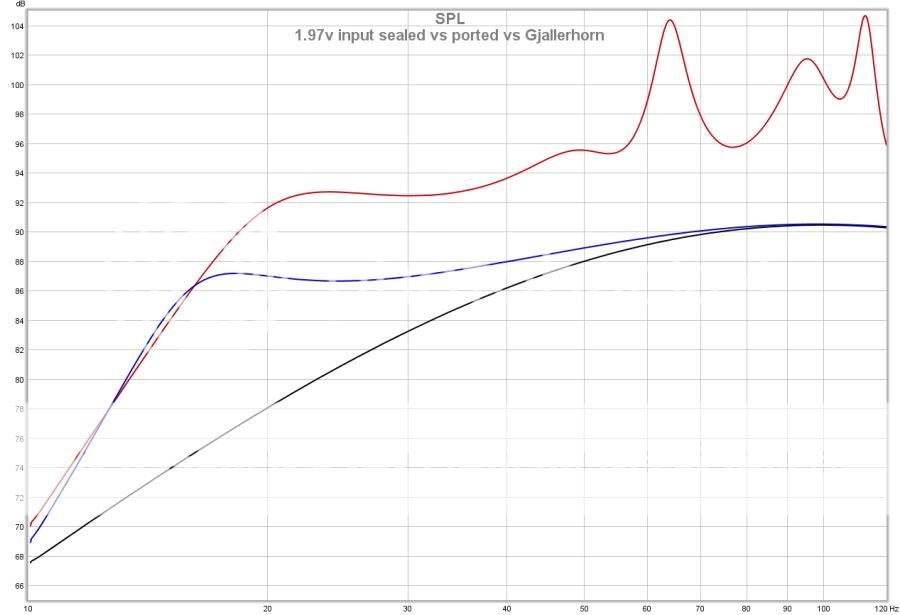
Here is the same comparison with the power input actually limited to 1w. Actual 1W efficiency. This gives some indication of how heavy of a load each will be to an amplifier.
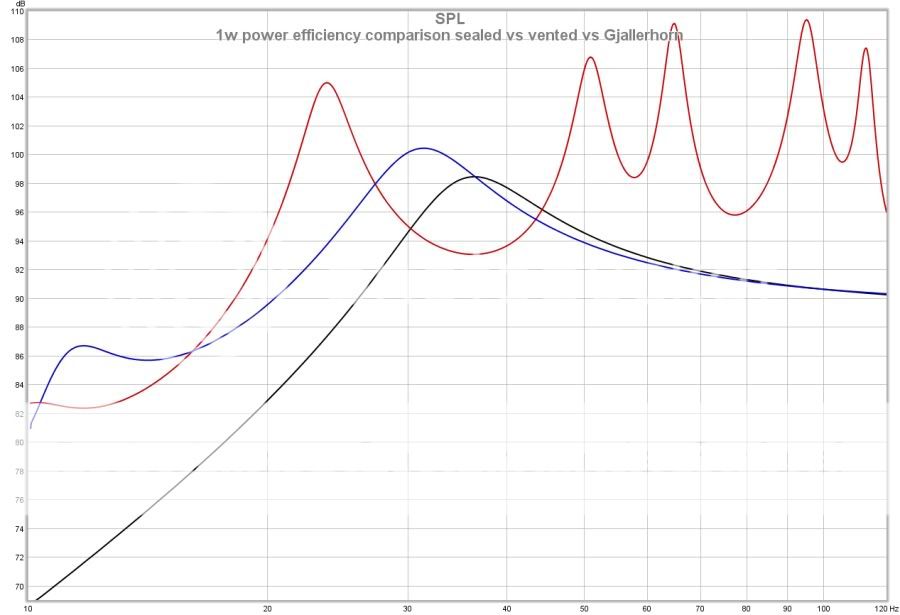
This shows the excursion of a 120L sealed enclosure versus the horn at the same voltage drive level.
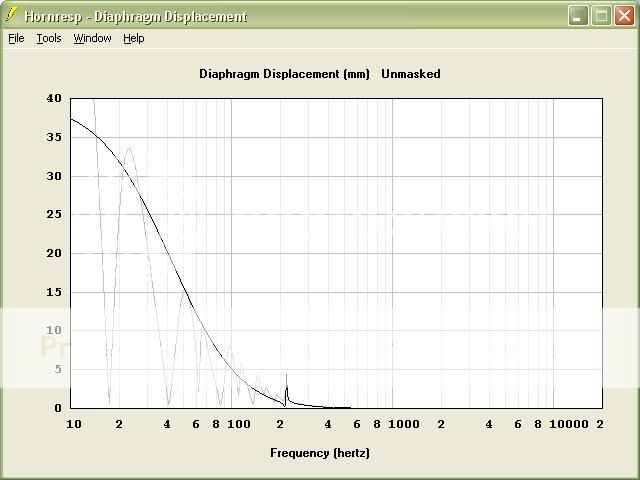

Here is the same comparison with the power input actually limited to 1w. Actual 1W efficiency. This gives some indication of how heavy of a load each will be to an amplifier.

This shows the excursion of a 120L sealed enclosure versus the horn at the same voltage drive level.

Here is a graph representing the estimated 2HD throat distortion at 130v input which is running it at ragged flat out peak levels. The values are not SPL but represent distortion percentage. I have an excel calculator set-up for it. You just import data from Akabak in and give it the cutoff and throat area. Then you can export it into REW. I suspect that it may be higher in practice with the throat area shrinking and expanding from driver excursion. Tom D. seems to be of the opinion that for most bass horns this is not an issue that is high on the priority list. Note that i am no expert in this area so it is possible that my math may be off. FWIW.
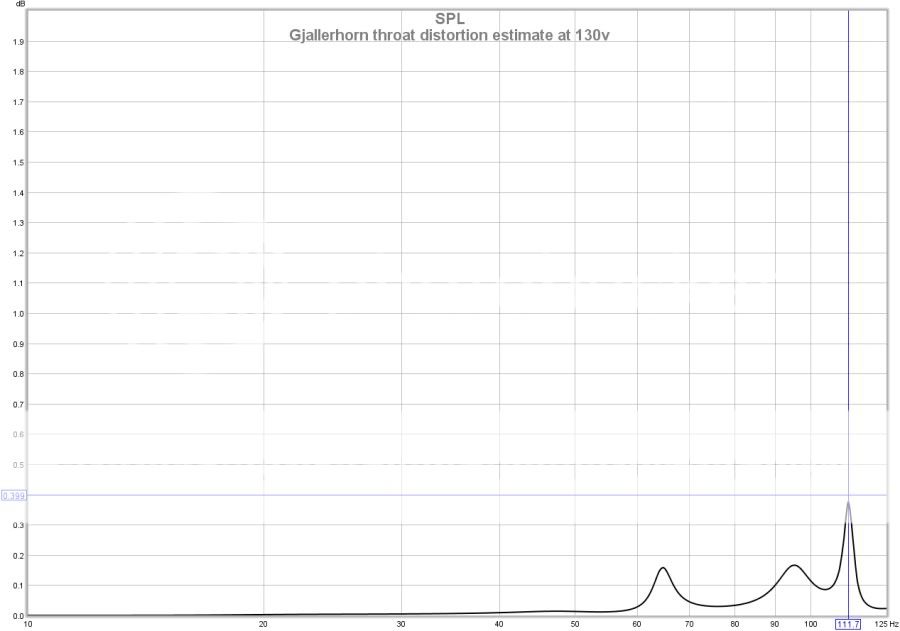

I ran about 5 sine sweeps through it, some pink noise, played a couple of sines at specific frequencies and ran about 3 songs through it.
I did get a close mic FR. Here it is compared with the simulated response.
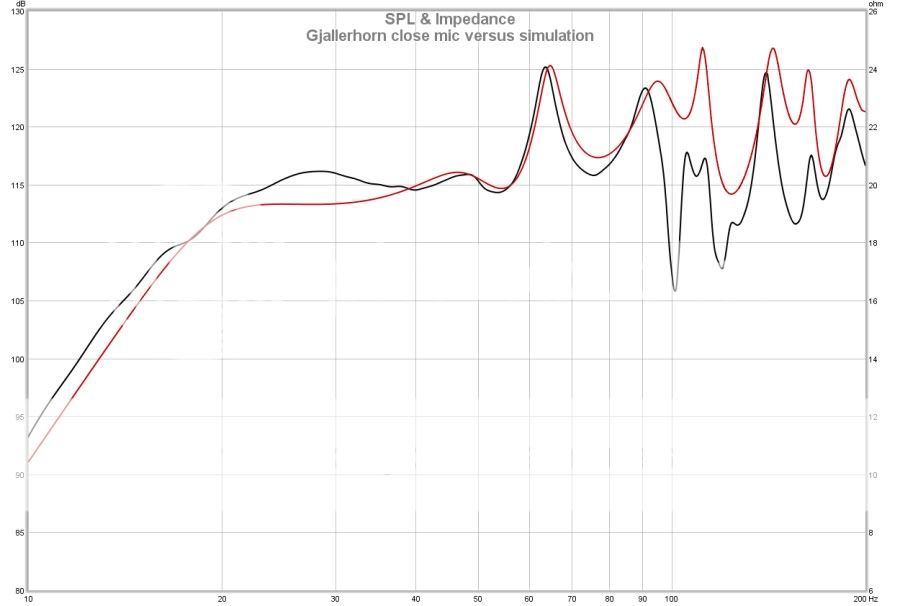
Well in some ways I am a little disappointed that the top end is not as good as hoped, which would've been merely rough to begin with instead of plain old beat up. I was hoping for it to be useful up to 100hz maybe with help from EQ. The null at 100hz is my biggest let down. On the other hand I am quite happy that it is as close as it is. I've never designed a horn before and this is a big and complicated one. I had no rough draft so it might not have worked at all! I could've gotten much worse. Also I had to expect that the sheer amount of turns in the middle section would have a detrimental and somewhat unknown effect. I'd suspect that these plus the internal resonances formed inside by the cab geometry have some large part in it as well. On the other hand as I had suspected it would the actual cab tuning came in a little lower than designed. This measurement was really rough and quick and at a pretty hot level, so I have no idea how the actual 1W efficiency will stack up. After I measure the other cab and do an outdoor gp test with a known voltage input I will have a better picture.
Here is a quick measured impedance. This wasn't really calibrated so the exact impedance magnitude may be a bit off but it shows that the peaks are close to the simulation and that the actual loading is a little bit lower in frequency than as designed. I did not recalibrate and I was using much longer leads than usual. I will have to redo this later with a proper calibration as well.
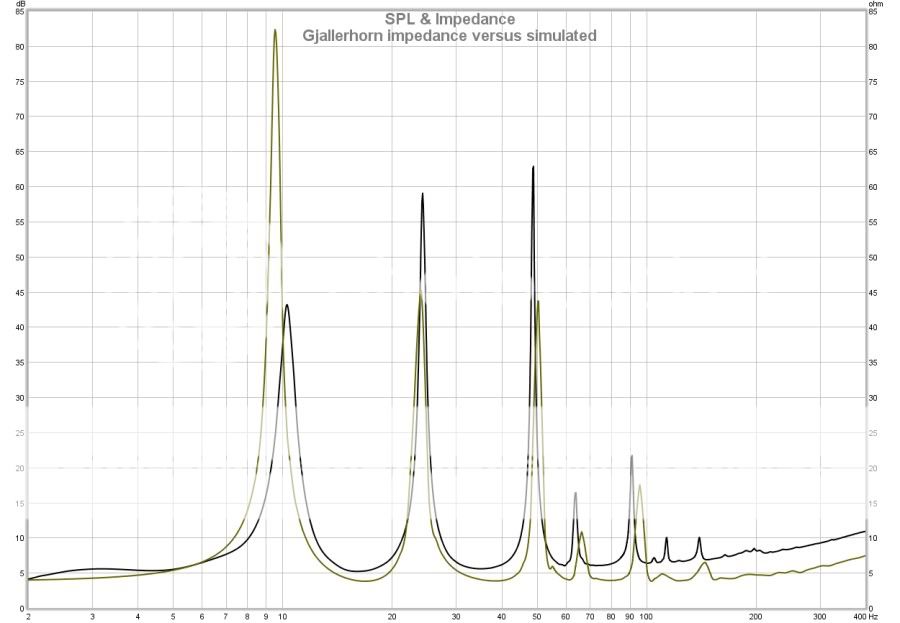
Some other quick observations are that these will definitely need a good dose of eq applied as mandatory and /or crossed over low like 60hz or lower. The cab does not want to let go of some notes. I do not have any damping at all in the cab currently I think there is a need for some. I can only reach the throat and the final 2 corners but I will see if this helps out at all. Also the cab is solid as a rock except for the bottom by the access panel where it is quite resonant. I knew this would be the case since the nature of the design didn't really allow any bracing in there and it is right by the driver back wave. The positive about that is that it is the bottom of the cab and in my application will be sitting on the floor with the full 300lb? weight on it. It won't be a problem in that case. I didn't wring the thing out but I did give it a little juice and thus far it doesn't appear that there will be any broken cone from horn pressure shenanigans. Its an angry little beastie. It slappa da bass around like it just don't care mon! . I can't really say that I am surprised by much of this. Par for the course so far.
. I can't really say that I am surprised by much of this. Par for the course so far.
I am not sure what the cause of the 100hz null is. 100hz is a roughly 11.25 ft long wavelength. This is a 22 ft long horn with many turns and sections. It is most likely some interaction with the cabinet dimensions causing a cancellation. Maybe it is the driver placement relative to a return reflection. Perhaps I can determine it later. That is actually the main thing that bugs me is the suck out at 100hz. Peaks can be cut heavily but nulls are not so easily dealt with.
I did throw some rough eq on it last night to beat down 63hz and 91hz and slapped an 80hz bw 4th order on. That made a big improvement in cleaning up the sound judging from the music cuts that I listened to. Output is not a problem. I wish that I had a way to watch movies in there so I can give it LFE channel to sink its teeth into, but I don't have my pc up there currently. Music just doesn't have much for it.
A full suite of outdoor 2m gp tests are in the future for this cab so hopefully in a couple of weeks there will be a much clearer picture as to what the final result actually is.
I did get a close mic FR. Here it is compared with the simulated response.

Well in some ways I am a little disappointed that the top end is not as good as hoped, which would've been merely rough to begin with instead of plain old beat up. I was hoping for it to be useful up to 100hz maybe with help from EQ. The null at 100hz is my biggest let down. On the other hand I am quite happy that it is as close as it is. I've never designed a horn before and this is a big and complicated one. I had no rough draft so it might not have worked at all! I could've gotten much worse. Also I had to expect that the sheer amount of turns in the middle section would have a detrimental and somewhat unknown effect. I'd suspect that these plus the internal resonances formed inside by the cab geometry have some large part in it as well. On the other hand as I had suspected it would the actual cab tuning came in a little lower than designed. This measurement was really rough and quick and at a pretty hot level, so I have no idea how the actual 1W efficiency will stack up. After I measure the other cab and do an outdoor gp test with a known voltage input I will have a better picture.
Here is a quick measured impedance. This wasn't really calibrated so the exact impedance magnitude may be a bit off but it shows that the peaks are close to the simulation and that the actual loading is a little bit lower in frequency than as designed. I did not recalibrate and I was using much longer leads than usual. I will have to redo this later with a proper calibration as well.

Some other quick observations are that these will definitely need a good dose of eq applied as mandatory and /or crossed over low like 60hz or lower. The cab does not want to let go of some notes. I do not have any damping at all in the cab currently I think there is a need for some. I can only reach the throat and the final 2 corners but I will see if this helps out at all. Also the cab is solid as a rock except for the bottom by the access panel where it is quite resonant. I knew this would be the case since the nature of the design didn't really allow any bracing in there and it is right by the driver back wave. The positive about that is that it is the bottom of the cab and in my application will be sitting on the floor with the full 300lb? weight on it. It won't be a problem in that case. I didn't wring the thing out but I did give it a little juice and thus far it doesn't appear that there will be any broken cone from horn pressure shenanigans. Its an angry little beastie. It slappa da bass around like it just don't care mon!
I am not sure what the cause of the 100hz null is. 100hz is a roughly 11.25 ft long wavelength. This is a 22 ft long horn with many turns and sections. It is most likely some interaction with the cabinet dimensions causing a cancellation. Maybe it is the driver placement relative to a return reflection. Perhaps I can determine it later. That is actually the main thing that bugs me is the suck out at 100hz. Peaks can be cut heavily but nulls are not so easily dealt with.
I did throw some rough eq on it last night to beat down 63hz and 91hz and slapped an 80hz bw 4th order on. That made a big improvement in cleaning up the sound judging from the music cuts that I listened to. Output is not a problem. I wish that I had a way to watch movies in there so I can give it LFE channel to sink its teeth into, but I don't have my pc up there currently. Music just doesn't have much for it.
A full suite of outdoor 2m gp tests are in the future for this cab so hopefully in a couple of weeks there will be a much clearer picture as to what the final result actually is.
congrates on the bild .
.
i wish i could hear it.
i think i remember someone saying(jbell?)that in modeling a th,one should try to avoid pathlengts of the same size.
i think (if still posible) damping at strategic points might help.
the hornpath from fornt >rear of the speaker is 5.9 mtrs,total length 6.8 mtrs.
wl of 100hz =3.4 mtrs.
maybe there is some formula to calculate this?
others might contribute in this field.
edit/after re-reading yor posts again,you came to the same conclusion.
erik
 .
.i wish i could hear it.
i think i remember someone saying(jbell?)that in modeling a th,one should try to avoid pathlengts of the same size.
i think (if still posible) damping at strategic points might help.
the hornpath from fornt >rear of the speaker is 5.9 mtrs,total length 6.8 mtrs.
wl of 100hz =3.4 mtrs.
maybe there is some formula to calculate this?
others might contribute in this field.
edit/after re-reading yor posts again,you came to the same conclusion.
erik
Last edited:
Anyway here is a rough HornResponse approximation of the Akabak script.
Hi Josh,
The 4-segment Hornresp approximation doesn't appear to be too rough, when compared to the 48-segment AkAbak result
See attached comparison.
Kind regards,
David
Attachments
Hi Josh,
The 4-segment Hornresp approximation doesn't appear to be too rough, when compared to the 48-segment AkAbak result.
See attached comparison.
Kind regards,
David
Ha! Yes not too rough. Amazingly close actually all things considered.
Hi
@ Josh Ricci
Hi
First off, congrats on attempting this, the AkaBak work, & the nice looking photos of the build
I wonder what made you choose a driver, mainly designed for vehicles ? I know there is no law etc that says you can't, thank goodness. I expect for one you were attracted to the quoted Xmax: 38.1 & Power handling: 2,000 watts RMS & Fs: 20.5 Hz apart from anything else. As impressive as they are though, one of the things that most of the vehicle drivers i've looked at, fall down on is Sensitivity, = SPL: 89.7 dB in this case.
Choosing a non vehicle driver opens up the field Considerably, with quite a number of candidates. For eg, a large driver with less power capabilities, but higher sensitivity, would easily match or exceed the SPL of most vehicle drivers. Did you model any such drivers, if so which ones & what did you discover ?
Also i would be concerned about the "rubberised" etc surround for sustained periods of time at high power, & also in the long term. My experience with drivers with similar surrounds on Commercial cabinets, is they don't last very long as they tear apart. This "might" not be the case with the LMS Ultra 5400, or some others, and i only mention it as a precaution, as they are not cheap ! And neither is the recone kit = replacement basket !
I see no mention of Xmax on TC's www ? only Xmech = Mechanical displacement limit (one way) Xmax is listed on PE as above. So i'm curious to know what Actual the Pk - PK Xmax "Official" specs are.
I find it strange that TC Sounds don't "appear" to list the T/S parameters for it ? TC Sounds Inc. I did find them on TC Sounds LMS Ultra 5400 18" DVC Subwoofer But no mention of Pk or Pk - Pk ?
Re - damping
My experience in designing/build bass/sub cabs is not to use any. Unless whatever material/s are used, are VERY firmly secured, they can cause more trouble than not. This is because high air pressures move the damping, in some cases quite considerably, which affects & interacts with the T/S parameters in real time, and/or some lag. This obviously affects the response in all sorts of unpredicatable ways. Also any damping is only really effective at higher frequencies than bass.
I think trying to run those/similar cabs higher than 80Hz will not achieve what you desire.
22 divided by 11 = 2 = I believe = destructive interference.
I sincerely hope you take my observations/advice in the way they are intended, & wish you All the best with it
@ Josh Ricci
Hi
First off, congrats on attempting this, the AkaBak work, & the nice looking photos of the build
I wonder what made you choose a driver, mainly designed for vehicles ? I know there is no law etc that says you can't, thank goodness. I expect for one you were attracted to the quoted Xmax: 38.1 & Power handling: 2,000 watts RMS & Fs: 20.5 Hz apart from anything else. As impressive as they are though, one of the things that most of the vehicle drivers i've looked at, fall down on is Sensitivity, = SPL: 89.7 dB in this case.
Choosing a non vehicle driver opens up the field Considerably, with quite a number of candidates. For eg, a large driver with less power capabilities, but higher sensitivity, would easily match or exceed the SPL of most vehicle drivers. Did you model any such drivers, if so which ones & what did you discover ?
Also i would be concerned about the "rubberised" etc surround for sustained periods of time at high power, & also in the long term. My experience with drivers with similar surrounds on Commercial cabinets, is they don't last very long as they tear apart. This "might" not be the case with the LMS Ultra 5400, or some others, and i only mention it as a precaution, as they are not cheap ! And neither is the recone kit = replacement basket !
I see no mention of Xmax on TC's www ? only Xmech = Mechanical displacement limit (one way) Xmax is listed on PE as above. So i'm curious to know what Actual the Pk - PK Xmax "Official" specs are.
I find it strange that TC Sounds don't "appear" to list the T/S parameters for it ? TC Sounds Inc. I did find them on TC Sounds LMS Ultra 5400 18" DVC Subwoofer But no mention of Pk or Pk - Pk ?
Re - damping
My experience in designing/build bass/sub cabs is not to use any. Unless whatever material/s are used, are VERY firmly secured, they can cause more trouble than not. This is because high air pressures move the damping, in some cases quite considerably, which affects & interacts with the T/S parameters in real time, and/or some lag. This obviously affects the response in all sorts of unpredicatable ways. Also any damping is only really effective at higher frequencies than bass.
I think trying to run those/similar cabs higher than 80Hz will not achieve what you desire.
I am not sure what the cause of the 100hz null is. 100hz is a roughly 11.25 ft long wavelength. This is a 22 ft long horn.
22 divided by 11 = 2 = I believe = destructive interference.
I sincerely hope you take my observations/advice in the way they are intended, & wish you All the best with it
Zero D no offense taken.
First thing is that I do not look at drivers based on the field they are generally used in. That is pretty much pointless to me other than to get perhaps a guess as to the componentry in its design. I look for drivers that fit the intended application. I also look at manufacturer specs with a grain on salt. I have seen far too many that do not live up to the billing. This driver is used for a diy HT driver far more than car audio. Also it has been thoroughly tested by quite a few different 3rd party sources including Klippel testing. I have used this driver long before the horns. However skeptical you may be of the performance claims I assure this driver has been thoroughly vetted and backs them up. There are tons of builds and data available on it.
I have some "different" views on some things than most people. I don't want to get too far into that. I do have a good amount of experience with many highly considered pro drivers. None of them will do what this one should in this cab. These are for low bass and regardless of using a horn or not you still need a lot of displacement to make low bass. Most pro drivers will have some 6-8 db less displacement limited headroom. Efficiency is great but in bass it is dominated by the cabinet volume, the corner chosen, and the motor strength( I mean bl^2/RE). In these days of cheap watts power is not an issue. Efficiency is great but doesn't mean a whole lot if the displacement isn't enough to handle some power. I doubt that you would be able to achieve the same corner and total cab size and get much more efficiency than a db or 2 regardless of the rating of the driver. I find the sensitivity spec one of the most useless for subwoofers. These usually have little bearing on the performance below 100hz given the way they are gathered.
A half wave cancellation makes sense since the horn is 22 ft and 100hz is roughly half of that. However if this is a typical type of resonance due to the total length shouldn't it have shown up in the simulation?
First thing is that I do not look at drivers based on the field they are generally used in. That is pretty much pointless to me other than to get perhaps a guess as to the componentry in its design. I look for drivers that fit the intended application. I also look at manufacturer specs with a grain on salt. I have seen far too many that do not live up to the billing. This driver is used for a diy HT driver far more than car audio. Also it has been thoroughly tested by quite a few different 3rd party sources including Klippel testing. I have used this driver long before the horns. However skeptical you may be of the performance claims I assure this driver has been thoroughly vetted and backs them up. There are tons of builds and data available on it.
I have some "different" views on some things than most people. I don't want to get too far into that. I do have a good amount of experience with many highly considered pro drivers. None of them will do what this one should in this cab. These are for low bass and regardless of using a horn or not you still need a lot of displacement to make low bass. Most pro drivers will have some 6-8 db less displacement limited headroom. Efficiency is great but in bass it is dominated by the cabinet volume, the corner chosen, and the motor strength( I mean bl^2/RE). In these days of cheap watts power is not an issue. Efficiency is great but doesn't mean a whole lot if the displacement isn't enough to handle some power. I doubt that you would be able to achieve the same corner and total cab size and get much more efficiency than a db or 2 regardless of the rating of the driver. I find the sensitivity spec one of the most useless for subwoofers. These usually have little bearing on the performance below 100hz given the way they are gathered.
A half wave cancellation makes sense since the horn is 22 ft and 100hz is roughly half of that. However if this is a typical type of resonance due to the total length shouldn't it have shown up in the simulation?
A half wave cancellation makes sense since the horn is 22 ft and 100hz is roughly half of that. However if this is a typical type of resonance due to the total length shouldn't it have shown up in the simulation?
nope, construction matters.
The only place in your design where you have parallel opposing faces is the last segment before the mouth. I suspect that is where the back reflection is occurring.
- Status
- This old topic is closed. If you want to reopen this topic, contact a moderator using the "Report Post" button.
- Home
- Loudspeakers
- Subwoofers
- Gjallerhorn



